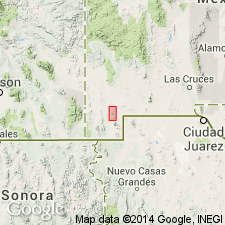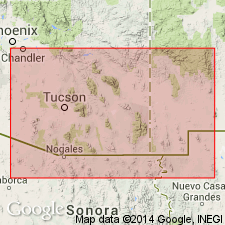
- Usage in publication:
-
- Broken Jug limestone*
- Modifications:
-
- Original reference
- Dominant lithology:
-
- Limestone
- Sandstone
- Shale
- Conglomerate
- AAPG geologic province:
-
- Pedregosa basin
Summary:
Pg. 531, figs. 2, 4; USGS Prof. Paper 208, p. 16-18, pl. 1, 1947. Broken Jug limestone of Bisbee group. Lowermost formation of Bisbee group. In general, consists of limestone, pure, shaly, and sandy, interbedded with sandstone, shale, and conglomerate. Coarse limestone conglomerate prominent locally. Red to green shale and sandstone present at three horizons in Eureka district. Thickness approximately 3,400 feet in Sylvanite district and perhaps more than 5,000 feet in Eureka district. Overlain by Howells Ridge formation (new) in Sylvanite district and by Ringbone shale (new) and Hidalgo volcanics (new) in Eureka district (all of Bisbee group). Age is Early Cretaceous (Trinity).
Named from Broken Jug Pass in Sylvanite part of Little Hatchet Mountains, where formation occupies several sq mi on east side of the crest. Makes up dissected chain of hills and ridges that front northeast corner of range, in Eureka district, southwestern NM. [Broken Jug Pass in secs. 34 and 35, T. 28 S., R. 16 W., Hatchita Peak 7.5-min quadrangle, Hidalgo Co., southwestern NM.]
Source: US geologic names lexicon (USGS Bull. 1200, p. 488).

- Usage in publication:
-
- Broken Jug Limestone*
- Modifications:
-
- Revised
- Overview
- AAPG geologic province:
-
- Pedregosa basin
- Basin-and-Range province
Summary:
Is formation in Little Hatchet Mountains, Hidalgo and Grant Cos, NM in the Pedregosa basin and Basin-and-Range province. Together with Howells Ridge and Playas Peak Formations of same area, all are interpreted to be faulted repetitions of same unit. Is not considered part of Bisbee Group; changed from previous work by Lasky (1947). Bisbee Group not used locally in this paper. Basal contact not exposed; underlies Ringbone Shale (Upper Cretaceous) in northern part of range with erosional unconformity. Thickness (following Lasky, 1947) as much as 5,000 ft. Upper few hundred ft characterized by thick-bedded to massive rudistid-bearing bioherms and ORBITOLINA-bearing beds of Trinity (Aptian and Albian, Early Cretaceous) age. Is correlated with U-Bar Formation (Aptian and Albian) of Zeller, Jr. (1965) in Big Hatchet Mountains on basis of lithology and fossils. Is Neocomian, Aptian, and Albian (Early Cretaceous) age. [See fig. 5 for regional correlation.]
Source: GNU records (USGS DDS-6; Denver GNULEX).

- Usage in publication:
-
- Broken Jug Limestone
- Modifications:
-
- Not used
- AAPG geologic province:
-
- Pedregosa basin
- Basin-and-Range province
Summary:
Not mapped in Little Hatchet Mountains. Rocks included in Broken Jug by Lasky (1938) here mapped as Hell-to-Finish or Mojado Formation. [Because of the generally accepted faulted duplication of the sequence as defined by Lasky (1938) in the Little Hatchet Mountains, probably most of his Cretaceous units, including Broken Jug, should be replaced by the better defined and more widely used terminology of Zeller (1970).] Is of Early Cretaceous age.
Source: GNU records (USGS DDS-6; Denver GNULEX).
For more information, please contact Nancy Stamm, Geologic Names Committee Secretary.
Asterisk (*) indicates published by U.S. Geological Survey authors.
"No current usage" (†) implies that a name has been abandoned or has fallen into disuse. Former usage and, if known, replacement name given in parentheses ( ).
Slash (/) indicates name conflicts with nomenclatural guidelines (CSN, 1933; ACSN, 1961, 1970; NACSN, 1983, 2005, 2021). May be explained within brackets ([ ]).

